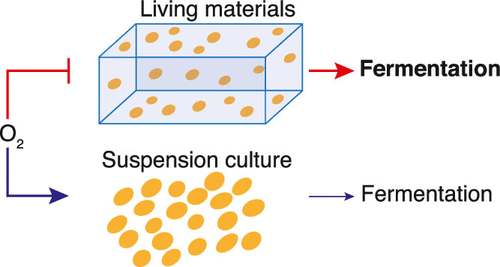当前位置:
X-MOL 学术
›
ACS Appl. Bio Mater.
›
论文详情
Our official English website, www.x-mol.net, welcomes your feedback! (Note: you will need to create a separate account there.)
Metabolism Control in 3D-Printed Living Materials Improves Fermentation
ACS Applied Bio Materials ( IF 4.7 ) Pub Date : 2021-08-30 , DOI: 10.1021/acsabm.1c00754 Tobias Butelmann 1, 2 , Hans Priks 1 , Zoel Parent 3 , Trevor G Johnston 3 , Tarmo Tamm 1 , Alshakim Nelson 3 , Petri-Jaan Lahtvee 1, 4 , Rahul Kumar 1, 4
ACS Applied Bio Materials ( IF 4.7 ) Pub Date : 2021-08-30 , DOI: 10.1021/acsabm.1c00754 Tobias Butelmann 1, 2 , Hans Priks 1 , Zoel Parent 3 , Trevor G Johnston 3 , Tarmo Tamm 1 , Alshakim Nelson 3 , Petri-Jaan Lahtvee 1, 4 , Rahul Kumar 1, 4
Affiliation

|
The three-dimensional (3D) printing of cell-containing polymeric hydrogels creates living materials (LMs), offering a platform for developing innovative technologies in areas like biosensors and biomanufacturing. The polymer material properties of cross-linkable F127-bis-urethane methacrylate (F127-BUM) allow reproducible 3D printing and stability in physiological conditions, making it suitable for fabricating LMs. Though F127-BUM-based LMs permit diffusion of solute molecules like glucose and ethanol, it remains unknown whether these are permissible for oxygen, essential for respiration. To determine oxygen permissibility, we quantified dissolved oxygen consumption by the budding yeast-laden F127-BUM-based LMs. Moreover, we obtained data on cell-retaining LMs, which allowed a direct comparison between LMs and suspension cultures. We further developed a highly reliable method to isolate cells from LMs for flow cytometry analysis, cell viability evaluation, and the purification of macromolecules. We found oxygen consumption heavily impaired inside LMs, indicating that yeast metabolism relies primarily on fermentation instead of respiration. Applying this finding to brewing, we observed a higher (3.7%) ethanol production using LMs than the traditional brewing process, indicating improved fermentation. Our study concludes that the present F127-BUM-based LMs are useful for microaerobic processes but developing aerobic bioprocesses will require further research.
中文翻译:

3D 打印生活材料中的代谢控制可改善发酵
含有细胞的聚合物水凝胶的三维 (3D) 打印创造了生命材料 (LM),为在生物传感器和生物制造等领域开发创新技术提供了平台。可交联的 F127-双氨基甲酸酯甲基丙烯酸酯 (F127-BUM) 的聚合物材料特性允许在生理条件下进行可重复的 3D 打印和稳定性,使其适用于制造 LM。尽管基于 F127-BUM 的 LM 允许葡萄糖和乙醇等溶质分子的扩散,但尚不清楚这些是否允许氧气,这是呼吸所必需的。为了确定氧气允许性,我们量化了基于萌芽酵母的 F127-BUM LMs 的溶解氧消耗量。此外,我们获得了有关细胞保留 LM 的数据,这允许直接比较 LM 和悬浮培养物。我们进一步开发了一种高度可靠的方法,用于从 LM 中分离细胞,用于流式细胞术分析、细胞活力评估和大分子纯化。我们发现 LMs 内部的耗氧量严重受损,这表明酵母代谢主要依赖于发酵而不是呼吸作用。将这一发现应用于酿造,我们观察到使用 LM 的乙醇产量高于传统酿造工艺(3.7%),表明发酵得到改善。我们的研究得出结论,目前基于 F127-BUM 的 LM 可用于微需氧过程,但开发需氧生物过程需要进一步研究。表明酵母代谢主要依赖于发酵而不是呼吸。将这一发现应用于酿造,我们观察到使用 LM 的乙醇产量高于传统酿造工艺(3.7%),表明发酵得到改善。我们的研究得出结论,目前基于 F127-BUM 的 LM 可用于微需氧过程,但开发需氧生物过程需要进一步研究。表明酵母代谢主要依赖于发酵而不是呼吸。将这一发现应用于酿造,我们观察到使用 LM 的乙醇产量高于传统酿造工艺(3.7%),表明发酵得到改善。我们的研究得出结论,目前基于 F127-BUM 的 LM 可用于微需氧过程,但开发需氧生物过程需要进一步研究。
更新日期:2021-09-20
中文翻译:

3D 打印生活材料中的代谢控制可改善发酵
含有细胞的聚合物水凝胶的三维 (3D) 打印创造了生命材料 (LM),为在生物传感器和生物制造等领域开发创新技术提供了平台。可交联的 F127-双氨基甲酸酯甲基丙烯酸酯 (F127-BUM) 的聚合物材料特性允许在生理条件下进行可重复的 3D 打印和稳定性,使其适用于制造 LM。尽管基于 F127-BUM 的 LM 允许葡萄糖和乙醇等溶质分子的扩散,但尚不清楚这些是否允许氧气,这是呼吸所必需的。为了确定氧气允许性,我们量化了基于萌芽酵母的 F127-BUM LMs 的溶解氧消耗量。此外,我们获得了有关细胞保留 LM 的数据,这允许直接比较 LM 和悬浮培养物。我们进一步开发了一种高度可靠的方法,用于从 LM 中分离细胞,用于流式细胞术分析、细胞活力评估和大分子纯化。我们发现 LMs 内部的耗氧量严重受损,这表明酵母代谢主要依赖于发酵而不是呼吸作用。将这一发现应用于酿造,我们观察到使用 LM 的乙醇产量高于传统酿造工艺(3.7%),表明发酵得到改善。我们的研究得出结论,目前基于 F127-BUM 的 LM 可用于微需氧过程,但开发需氧生物过程需要进一步研究。表明酵母代谢主要依赖于发酵而不是呼吸。将这一发现应用于酿造,我们观察到使用 LM 的乙醇产量高于传统酿造工艺(3.7%),表明发酵得到改善。我们的研究得出结论,目前基于 F127-BUM 的 LM 可用于微需氧过程,但开发需氧生物过程需要进一步研究。表明酵母代谢主要依赖于发酵而不是呼吸。将这一发现应用于酿造,我们观察到使用 LM 的乙醇产量高于传统酿造工艺(3.7%),表明发酵得到改善。我们的研究得出结论,目前基于 F127-BUM 的 LM 可用于微需氧过程,但开发需氧生物过程需要进一步研究。



























 京公网安备 11010802027423号
京公网安备 11010802027423号